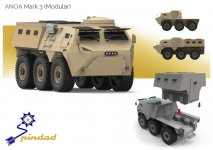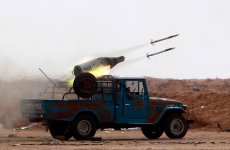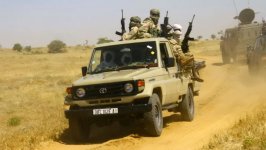- Reaction score
- 35
- Points
- 560
Just thinking about this a bit more, I realized that the evolution of various communications and sensor technologies is bringing us to the point Chris is talking about.
A Korean K-2 tank can fire a K-STAM (Korean Smart Top Attack Munition) and engage targets at 8km. A tank platoon could decimate a DPRK mechanized battalion without ever seeing them, as long as the ROK unit has an observer or dedicated UAV observing for them. An Isreali tank crew can do something similar with LAHAT out to 13km (same stipulation). The tank is evolving from a direct fire unit to a mobile protected fire platform.
Various forms of Fibre Optic Guided Missile (FOG-M) exist, some with ranges out to 60km. It is a point weapon which can engage at artillery ranges.
We have heard of the example off a USMC F-35 using its sensors to pick up an incoming missile and cue and fire a SAM from a nearby ship to intercept - the F-35 can also spot for a Marine artillery or missile battery. The US army has also demonstrated networking an artillery battery and using the information to use a 155mm howitzer to shoot down in incoming cruise missile.
So there are ways to radically extend or change the way we use current equipment (the simple example would be to buy the K-STAM rounds for Canadian Leopard 2 tanks), so long as we understand how extending the capabilities helps, and what additional things we need to use these extended capabilities.
A Korean K-2 tank can fire a K-STAM (Korean Smart Top Attack Munition) and engage targets at 8km. A tank platoon could decimate a DPRK mechanized battalion without ever seeing them, as long as the ROK unit has an observer or dedicated UAV observing for them. An Isreali tank crew can do something similar with LAHAT out to 13km (same stipulation). The tank is evolving from a direct fire unit to a mobile protected fire platform.
Various forms of Fibre Optic Guided Missile (FOG-M) exist, some with ranges out to 60km. It is a point weapon which can engage at artillery ranges.
We have heard of the example off a USMC F-35 using its sensors to pick up an incoming missile and cue and fire a SAM from a nearby ship to intercept - the F-35 can also spot for a Marine artillery or missile battery. The US army has also demonstrated networking an artillery battery and using the information to use a 155mm howitzer to shoot down in incoming cruise missile.
So there are ways to radically extend or change the way we use current equipment (the simple example would be to buy the K-STAM rounds for Canadian Leopard 2 tanks), so long as we understand how extending the capabilities helps, and what additional things we need to use these extended capabilities.





